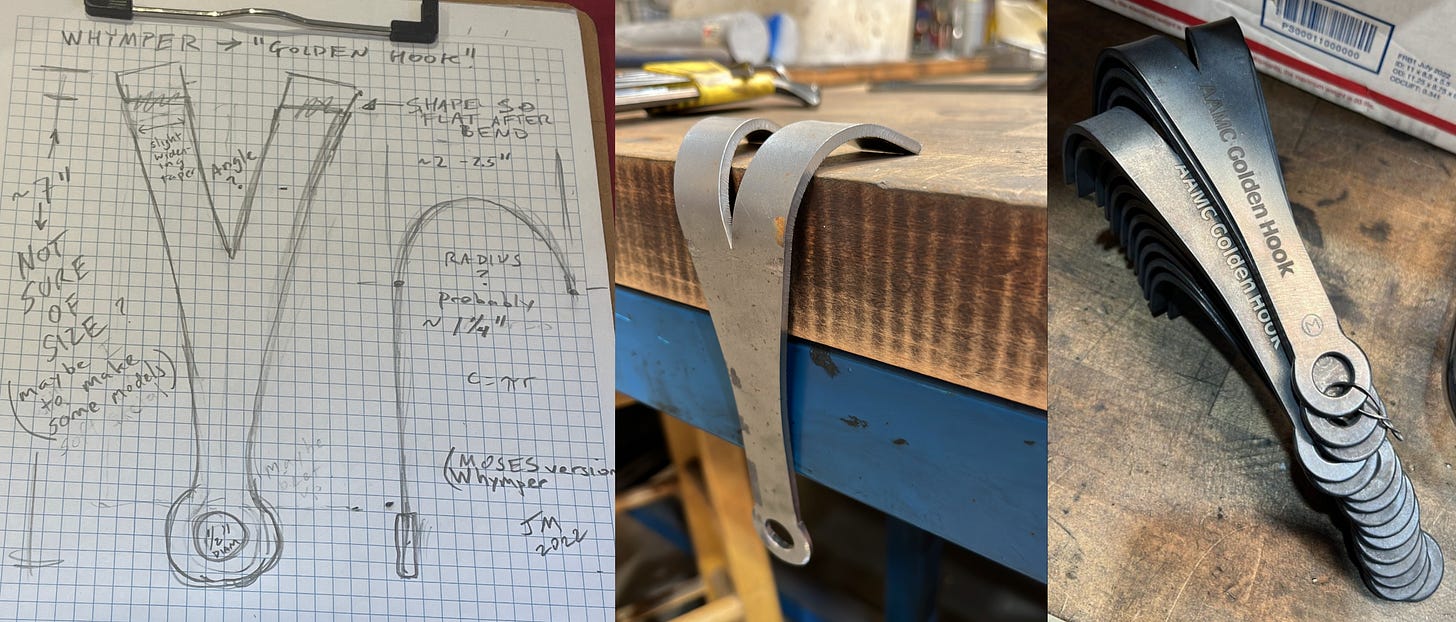Golden Hook Awards
random aside
Double Pronged Hooks
While researching the referenced uses of the famous Whymper hook, I realized what a versatile piece of equipment it probably was during the dawn of technical rock climbing utilizing engineered tools in the late 19th century. The double-pronged hook always had a short piece of cord attached and was carried by experts like Georg Winkler to climb ever-steeper cliffs, with the downclimb potentially assisted by an occasional cord hanging from a metal claw set on a flat edge (see Volume 1, Mechanical Advantage: Tools for the Wild Vertical on Archive.org).

Golden Hook Award
So with all the awards proliferating our sport of climbing, I looked around and discovered a lot of “golden” awards, like the Golden Piton award from Climbing Magazine, or the golden ice axes from Piolet d’Or. So I set up the Golden Hook™™ award with the national Australian Mountaineering and Climbing Club (amcc.app), and five awards have been distributed five so far.
Hooks were the first real ‘clean’ climbing tool, of course, and were largely replaced by the more secured pitons developed as the tools and materials for rock climbing advanced. The first pitons were also called ‘hooks’, various designs that were nailed into cracks for security. The last references in the literature of the so-called ‘Whymper hooks’ predate WWI, supplanted by an effective hammer, piton, and carabiner system, and well-designed clean-climbing gear wouldn’t resurface until the 1960s. Modern hooks for aid climbing, made from stronger steel, would also advance in the 1960s.
Theron Moses, of Moses Enterprises, known for quality hardware that combines old-school techniques with modern technologies, and I re-designed the Whymper hook from the only known sketch of the tool published by Whymper in his autobiography, Scrambles Amongst the Alps in the years 1860-69 (illustration above).
The award is a double-pronged hook modeled after the only existing diagram of the tool, published by Whymper (illustration above). Even though these were being built on a lark, we wanted to ensure that they would be strong, and probably much stronger than what people were relying on in the 1800s, with modern steels and heat treatments. Theron whipped out a nice batch after I sent him a simple sketch.
For this unique international climbing award, I haven’t had time to announce all the winners, so here they are so far. These are informal awards, given randomly, and note the sharing of inspiration and fun, as well as the original criteria noted below. The first two were to those who have been sharing cool progress of tools and techniques on Instagram.
#1: Genoveva aka Genofoto solo aid climber.
”I climb alone (99%) for FUN & FREEDOM mostly on small crags.”
#2: Scott Peterson, adventure climber, for inspiring toughness bigwalling in Yosemite.
The next three Golden Hook awards were given for one of the most amazing Karakoram expeditions ever, the 1990 Japan Trango expedition (draft story here).
Appendix
Original Golden Hook Criteria (submitted to the AAC)
Grants and Awards will be based on three criteria:
Visionary bold bigwall lines.
Minimum impact--low resource impact and minimal abandoned materiel.
Style--committing and efficient ground-up weather-timed team ascents.
p.s. Did I mention? D4 Designs, headquartered in Tasmania, also sponsors the antipodal Java awards:
;)






